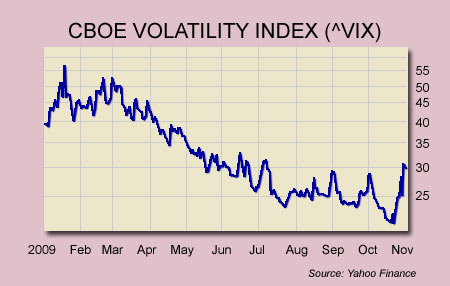Use fear to drive your investment decisions
There are only two forces that move markets: fear and greed. And one 'fear index' is an excellent signal of market direction, says Karim Rahemtulla. Here's how it can guide your investment decisions.
There are only two driving forces that move the stock market: fear and greed.
Based on these two hugely influential factors, many investors simply watch the market's daily gyrations and listen to the folks on television scream and shout about it - without offering any solid, profitable advice.
But one index holds all the clues you need. It's called the CBOE Volatility Index (^VIX) and it essentially measures investor sentiment, based on how options are trading on the S&P 500. It's sometimes referred to as the "Fear/Greed Index" because at specific points in time, the VIX has been an excellent predictor of the market's future direction.
MoneyWeek
Subscribe to MoneyWeek today and get your first six magazine issues absolutely FREE

Sign up to Money Morning
Don't miss the latest investment and personal finances news, market analysis, plus money-saving tips with our free twice-daily newsletter
Don't miss the latest investment and personal finances news, market analysis, plus money-saving tips with our free twice-daily newsletter
Here's how it works - and how you can use it to your advantage...
What you should do when the VIX is high or low
Want to know the best times to buy and sell stocks? Just look at the VIX...
When the VIX is high: Any time the VIX hits 50 points or higher, it usually signals that investors are fearful, or panicking. This is the best time to buy stocks.
When the VIX is low: If the VIX drops under 20, or close to the ten-point level, it implies that investors are complacent and you should lighten up on your positions.
So what's going on today?

The VIX currently sits around30 points - a pretty low level, indicating that the market is relatively stable. However, based on what we've seen over the past few months, it would be ridiculous to imply that volatility has disappeared from the market.
We're clearly not out of the woods when it comes to volatility... yet the market is proving people wrong on a daily basis. So let's turn the tables on the market by using volatility to our advantage...
The four ways to price options
If you're a longer-term investor, listen up because Christmas has come early. Here's why...
Volatility is a key component of how options are priced, not the whims of market makers. The pricing formula involves four components, determined by the Black-Scholes Model...
Time to expiration: The more time you have before your option expires, the more valuable it is.
Underlying share price: The further out-of-the-money the option's strike price is (strike price refers to the price at which you can buy or sell the underlying share), the less it is worth.
Risk-free rate of return: This measures the cost of money. A good number to use is the yield from a 10-year Treasury bond.
Implied volatility: In my opinion, this is the most important factor. It refers to the implied volatility of the underlying shares - i.e. how much action there is in the price of the underlying shares, and therefore, the options - versus a move in the market. The higher the implied volatility of a stock, the more the option will move in a particular direction.
Use this link to find out the implied volatility for a particular stock.
Here's where you can find an options pricing calculator.
When volatility is low, so is the price for options - down from their lofty levels of March 2009 and November 2008. And while that doesn't help short-term options buyers, as I noted earlier, it's a wonderful present for investors focused on the longer-term picture because there's more time for events to play out in your favor.
So if you have a two-year time horizon, you just got handed a big fat present - a cheaper way to bet on the direction of stocks.

- Why UK property prices are going to fall 50%
- When it will be time to get back in and buy up half price property
What you need to do now
Look at the stocks in your portfolio and see if any of them have LEAP options available with 2011, or 2012 expiration dates (yes, there are LEAPS that expire in 2012!).
If you've got some big gains, or hold big positions that you're nervous about, sell them and buy LEAP options as a proxy.
For example, if you hold 1,000 shares of JP Morgan (NYSE: JPM), you can cash out for $46,000 and do this instead...
Buy JPM LEAPS that expire in 2012 with a $25 strike price for $22.
Based on JPM's current price of $46, you're paying a $1 net premium to own the right to control the same shares.
This deep-in-the-money option will move up and down almost dollar-for-dollar with JPM's share price. But you take $24,000 off the table - money you can put to use elsewhere.
Another example is with a company like Bank of America (NYSE: BAC).
If you think shares are headed higher, you could buy 1,000 shares today for $16,000.
A better strategy, though, would be to buy the 2012, $17.50 options for $4.80, spending about 30% of what you would if you bought the shares.
But remember when you buy an option, the most you can lose is what you spent for it. And if you decide to employ a stop-loss, you can mitigate even more risk.
So next time you're thinking about buying a stock, know that you can have your cake and eat it too by employing a LEAPS strategy.
This article was written by Karim Rahemtulla and was first published on 30 October in the daily investment newsletter Investment U
Get the latest financial news, insights and expert analysis from our award-winning MoneyWeek team, to help you understand what really matters when it comes to your finances.
MoneyWeek is written by a team of experienced and award-winning journalists, plus expert columnists. As well as daily digital news and features, MoneyWeek also publishes a weekly magazine, covering investing and personal finance. From share tips, pensions, gold to practical investment tips - we provide a round-up to help you make money and keep it.
-
 Mortgage market reforms: how the FCA's new affordability rules could help you onto the property ladder
Mortgage market reforms: how the FCA's new affordability rules could help you onto the property ladderThe Financial Conduct Authority (FCA) will consult on a range of changes to mortgage lending rules in 2026 to help underserved borrowers
-
 Quality emerging market companies with consistent returns
Quality emerging market companies with consistent returnsOpinion Mark Hammonds, portfolio manager at Guinness Global Investors, selects three emerging market stocks where he'd put his money

